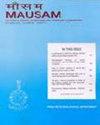亚洲夏季风的年代际变化及5月南海热带气旋频率
IF 0.7
4区 地球科学
Q4 METEOROLOGY & ATMOSPHERIC SCIENCES
引用次数: 0
摘要
亚洲夏季风的年代际变化以及北太平洋西部和南海的热带气旋活动具有重要的科学意义和社会意义。就5月份南海和菲律宾海的TC形成而言,2010-2019年被确定为1961年以来最不活跃的十年(Cho et al. 2022)。本文利用40年(1981-2020年)的数据进一步分析了南海5月TC频率与亚洲季风系统春夏转换的关系。结果表明,20世纪80年代和2000年代有两个活跃年,90年代和2010年代有两个不活跃年,TC频率具有明显的年代际变化。前20年的环流和地面气温对比与后20年的对比有很大的不同。这种差异可以理解为亚洲-澳大利亚-太平洋季风区40年3 - 6月降水的两个主要模态的年代际变化。在前20年,5月活跃和不活跃SCS TC频率的对比可以用EOF2的差异来解释。正EOF2对应于东印度洋对流增强和西太平洋暖池对流抑制的同步异常的干湿偶极子型。在之后的20年里,这种对比可以用EOF1的差异来解释,EOF1显示了东印度洋上空的经向偶极子模式,反映了ITCZ的北移。其中,2001-2010年是过渡带北移最早的10年,5月是南海TC频率最活跃的10年。尽管1981-1990年和1991-2000年的年代际变化显示出较强的TC频率差异,但季风季节转换没有明显的差异。本文章由计算机程序翻译,如有差异,请以英文原文为准。
Decadal-scale changes in the seasonal transition patterns of the Asian summer monsoon and the South China Sea tropical cyclone frequency during May
The decadal-scale variations of the Asian summer monsoon and the tropical cyclone (TC) activity over the western North Pacific (WNP) and the South China Sea (SCS) are of great scientific and societal importance. The period of 2010-2019 was identified as the most inactive decade since 1961 in terms of TC genesis over the SCS and the Philippine Sea during May (Cho et al. 2022). In this paper we extended the analysis by using 40-yr (1981-2020) data to illustrate the relationship between the SCS TC frequency in May and the spring-to-summer transition of Asian monsoon systems. The results show clear decadal-scale variations of TC frequency with two active decades during the 1980s and 2000s, and two inactive decades during the 1990s and 2010s. The circulation and surface air temperature contrast during the earlier two decades is drastically different from the contrast during later two decades. The difference can be understood as decadal-scale variations of two leading modes of the 40-yr March-June precipitation in Asian-Australian-Pacific monsoon region. For the earlier two decades, the contrast of active and inactive SCS TC frequency in May can be explained by the difference in EOF2. The positive EOF2 corresponds to a wet and dry dipole pattern of the concurrent anomalies with enhanced convection over the eastern Indian Ocean and suppressed convection over the western Pacific warm pool. For the later two decades, the contrast can be explained by the difference in EOF1, which shows a meridional dipole pattern over eastern Indian Ocean reflecting the northward movement of the ITCZ. Among four decades, the decade of 2001-2010 shows the earliest northward transition of the ITCZ and the most active SCS TC frequency in May. Although the decades of 1981-1990 and 1991-2000 show strong difference in TC frequency, no discernable difference in monsoon seasonal transition is detected.
求助全文
通过发布文献求助,成功后即可免费获取论文全文。
去求助
来源期刊

MAUSAM
地学-气象与大气科学
CiteScore
1.20
自引率
0.00%
发文量
1298
审稿时长
6-12 weeks
期刊介绍:
MAUSAM (Formerly Indian Journal of Meteorology, Hydrology & Geophysics), established in January 1950, is the quarterly research
journal brought out by the India Meteorological Department (IMD). MAUSAM is a medium for publication of original scientific
research work. MAUSAM is a premier scientific research journal published in this part of the world in the fields of Meteorology,
Hydrology & Geophysics. The four issues appear in January, April, July & October.
 求助内容:
求助内容: 应助结果提醒方式:
应助结果提醒方式:


